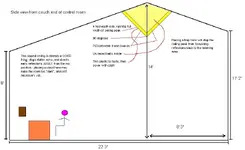D
DigitalDon
New member
Ethan or others,
I need some help with a freq cancellation problem in my control room. This control room has 6 corners (not including ceiling and floor of course). In the 2 corners behind me I installed Knauf 2" rigid across the corners from floor to ceiling. There is a couch behind me which I've installed a panel (4" deep framed Knauf 2" rigid) on each side between the couch and corners. I also have panels (same as above) on the wall behind my JBL 4311 full range monitors (a very wide angle corner is here). The cancellation problem I have is from 100 t0 125 Hz using the Minirator (from your website) as a signal source. It's there whether I use the JBL's or my M-Audio nearfields. Mic used is a Behringer ECM8000 into an Aardvark Q10. I tried other mics just to make sure it wasn't a bad mic. The cancellation is very audible when sitting in the mix position also. I'm losing as much as 15dB at these frequencies. As you can imagine, the low end of my mixes will almost blow the woofers out when played outside of the studio because I cranked in so much bass. I've learned to adjust my mixes to compensate but it's really getting old. I plan on building 2 more traps to place in the remaining 2 corners. My question is this: I have a vaulted suspended ceiling (14 feet at peak) with metal roof 18" above the ceiling. Do I need to place traps at any of these "corners" (wall meets suspended ceiling) at the side/back/front walls or do the low freqs pass on through the acoustic tiled ceiling and through the metal roof? Sorry this got so long but I'd like your opinion before buying materials to do all this. Oh yeah, floor is painted concrete and walls are sheetrock if it matters.
Thanks,
DD
I need some help with a freq cancellation problem in my control room. This control room has 6 corners (not including ceiling and floor of course). In the 2 corners behind me I installed Knauf 2" rigid across the corners from floor to ceiling. There is a couch behind me which I've installed a panel (4" deep framed Knauf 2" rigid) on each side between the couch and corners. I also have panels (same as above) on the wall behind my JBL 4311 full range monitors (a very wide angle corner is here). The cancellation problem I have is from 100 t0 125 Hz using the Minirator (from your website) as a signal source. It's there whether I use the JBL's or my M-Audio nearfields. Mic used is a Behringer ECM8000 into an Aardvark Q10. I tried other mics just to make sure it wasn't a bad mic. The cancellation is very audible when sitting in the mix position also. I'm losing as much as 15dB at these frequencies. As you can imagine, the low end of my mixes will almost blow the woofers out when played outside of the studio because I cranked in so much bass. I've learned to adjust my mixes to compensate but it's really getting old. I plan on building 2 more traps to place in the remaining 2 corners. My question is this: I have a vaulted suspended ceiling (14 feet at peak) with metal roof 18" above the ceiling. Do I need to place traps at any of these "corners" (wall meets suspended ceiling) at the side/back/front walls or do the low freqs pass on through the acoustic tiled ceiling and through the metal roof? Sorry this got so long but I'd like your opinion before buying materials to do all this. Oh yeah, floor is painted concrete and walls are sheetrock if it matters.
Thanks,
DD

 Just grabbing at straws here.
Just grabbing at straws here.